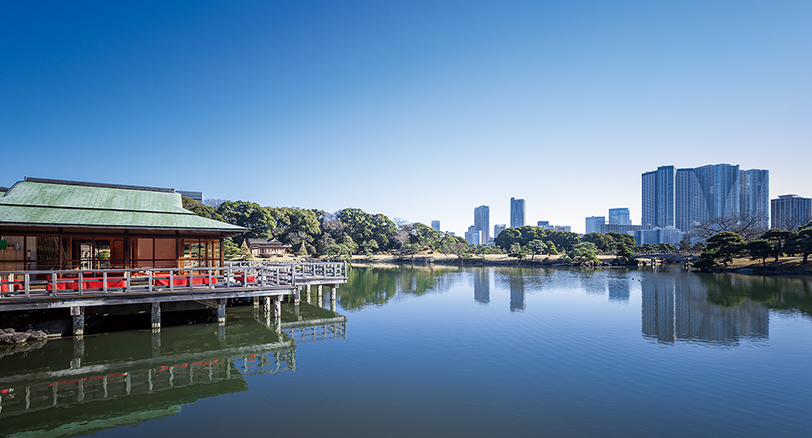Hama Rikyu Gardens is a serene oasis in the heart of Tokyo, beautifully blending traditional Japanese landscaping with modern skyscrapers. This comprehensive guide will introduce you to all aspects of this unique attraction.
Highlights at a Glance
- Large traditional Japanese garden located on Tokyo Bay
- Tidal ponds and teahouse creating picturesque scenes
- Beautiful in all seasons, especially during spring cherry blossoms and autumn foliage
- Striking contrast with surrounding modern architecture
- Rich history as a feudal lord’s residence and imperial detached palace
A Storied History
Hama Rikyu was established during the Edo Period (1603-1867) as a Tokyo residence and duck hunting ground for feudal lords. It later evolved into a strolling garden and even served as an imperial detached palace before opening to the public in its current form. Vestiges of its past roles are still visible throughout the garden, including reconstructed duck hunting blinds and remains of old moats and stone walls.
Main Attractions
Tidal Ponds and Nakajima Tea House
The tidal ponds are the centerpiece of Hama Rikyu Gardens. These unique seawater ponds change level with the tides of Tokyo Bay, showcasing the dynamic beauty of nature. At the center stands Nakajima Tea House, an elegant traditional Japanese building. Visitors can enjoy matcha tea here while admiring the surroundings. Built in 1707 and reconstructed several times, the current structure was restored to its original form in 1983. The view from the tea house offers a fascinating contrast between the ancient garden and modern skyscrapers.
300-Year-Old Pine and Otsutai Bridge
The most famous tree in the garden is a black pine known as the “300-Year-Old Pine.” This tree is said to be over three centuries old, serving as a living witness to the Edo period. Nearby is Otsutai Bridge, once a prime spot for Edo-period nobles to watch flying wild geese. Today, it offers the best vantage point for viewing the entire garden.
Plum Grove
The plum grove, located in the northeast part of the garden, boasts about 60 plum trees. From late February to early March, these trees burst into bloom with pink and white flowers, filling the air with their sweet fragrance. It’s an excellent spot for enjoying plum blossoms and learning about their cultural significance in Japan.
Cherry Blossom Area
While perhaps not as famous as Ueno Park for cherry blossoms, Hama Rikyu offers a more serene hanami experience. The garden has about 80 cherry trees, mainly of the Somei Yoshino variety. From late March to early April, pink blossoms adorn various corners of the garden, creating harmonious scenes with the greenery and water. The cherry trees along the tidal ponds are especially beautiful, their reflections creating a mesmerizing spring tableau.
Peony Garden
The peony garden in the southwest area is another springtime highlight. With about 250 peony plants of various species, it offers a vibrant color display. The best viewing time is from mid-April to early May. Besides admiring the beautiful flowers, visitors can learn about the peony’s important place in Japanese culture.
Canola Flower Field
In addition to cherry blossoms and peonies, Hama Rikyu features a field of golden canola flowers in spring. Located in the southern part of the garden, these flowers bloom from mid-March to mid-April. The sea of yellow not only adds beauty but also evokes images of the area’s past as farmland during the Edo period, adding a touch of historical flavor.
Duck Hunting Blinds
As a former shogun’s duck hunting ground, Hama Rikyu preserves several reconstructed duck hunting blinds. These structures allow visitors to imagine the hunting scenes of bygone noble life, offering an intriguing glimpse into Edo-period aristocratic pastimes.
Autumn Foliage
Autumn is another spectacular season at Hama Rikyu. The garden is home to various tree species, including maples and ginkgos. From late November to early December, these trees transform into a palette of red, orange, and gold, creating stunning contrasts with the garden’s greenery and water features. The maple grove near Otsutai Bridge is particularly noteworthy for autumn color appreciation.
These attractions showcase not only the natural beauty of Hama Rikyu throughout the seasons but also reflect the essence of Japanese garden art and the garden’s long history. Every corner is worth savoring, allowing visitors to experience tranquility and tradition in the heart of busy Tokyo.
Best Time to Visit
Hama Rikyu is beautiful year-round, with each season offering unique charms:
- Spring (Mar-May): Cherry blossoms, peonies, and other flowers in bloom
- Summer (Jun-Aug): Lush greenery and a cool retreat from the city heat
- Autumn (Sep-Nov): Stunning foliage and pleasant weather
- Winter (Dec-Feb): Plum blossoms and a uniquely serene garden atmosphere
Getting There
- 10-15 minute walk from JR Shimbashi Station
- 5-10 minute walk from Shiodome Station on the Oedo Subway Line or Yurikamome Line
- Accessible by water bus from Asakusa (35 minutes, 1180 yen one-way including garden admission)
Hours and Admission
- Open: 9:00 AM to 5:00 PM (last entry at 4:30 PM)
- Closed: December 29 to January 1
- Admission: 300 yen
Visitor Tips
- Wear comfortable walking shoes as the garden is quite large
- Bring a camera to capture the beautiful scenery
- Try matcha at the tea house for a traditional tea ceremony experience
- Spring and autumn are peak seasons; visit early to avoid crowds
- Check the official website for up-to-date information before your visit
Official Website
Conclusion
Hama Rikyu Gardens is a must-visit destination in Tokyo. It offers not only the beauty of traditional Japanese landscaping but also a unique fusion of old and new. Whether you’re a history enthusiast, a garden lover, or simply seeking a peaceful retreat in the bustling city, Hama Rikyu is well worth experiencing. Make sure to include this urban oasis in your Tokyo itinerary!
